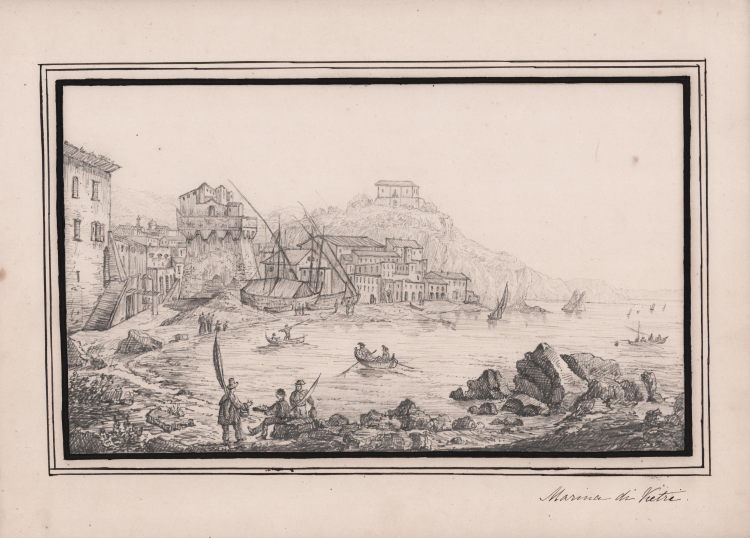



| Reference: | S47293 |
| Author | Antonio SENAPE |
| Year: | 1830 ca. |
| Zone: | Vietri sul Mare |
| Measures: | 365 x 265 mm |


| Reference: | S47293 |
| Author | Antonio SENAPE |
| Year: | 1830 ca. |
| Zone: | Vietri sul Mare |
| Measures: | 365 x 265 mm |
Original drawing on paper executed in pencil and gray ink, within border of triple fillet in brown ink; below marginal line, at right, manuscript title in contemporary handwriting.
The work is a significant example of the graphic production of Antonio Senape, a Roman painter active in southern Italy during the first half of the 19th century, who often drew inspiration from the Gulf of Naples and the Amalfi Coast to produce-perhaps on commission - albums of views: he himself, not surprisingly, liked to call himself a "draughtsman of villages with a pen."
The sheets were all done in pencil and pen in ink, often in two-tone, using black and sepia ink, without watercolor, with strokes now marked now thin; with sepia ink, which is more liquid, the painter made the foreground elements, and then proceeded to lay down the distant ones with strokes of black ink and to define with light pencil marks the blurring of the horizon-a method, as is known, also used by Piranesi, who used to mix several inks to enhance depths and effects, and which Mustard seems to have studied if many of his drawings, particularly the views of Neapolitan monuments, recall the stroke and layout.
Little is known about this calligraphic "draughtsman of countries with a pen," as Antonio Senape often called himself on the frontispieces of albums with his views.
A document recently unearthed by scholar Pier Andrea De Rosa attests that in 1815, at the age of twenty-seven, Senape stated in a parish census that he lived at No. 50 Via Gregoriana in Rome (archives of the Vicariate of Rome, parish of Sant'Andrea delle Fratte, Stati d'Anime 1815 f.n.n.). His date of birth, therefore, should be fixed in Rome around 1788; Roman, in fact, he declared himself in the margin of several drawings. It is likely that after 1815 Senape left his hometown to settle in southern Italy; in fact, while his views of Rome are very rare, the artist's entire output is centered in images of the South, of which the earliest are some Sicilian views (P. E. Trastulli 1998).
Later, he settled in Naples where he devoted himself to a production of views "from life." These were loose sheets, all made in pen and ink, thus not watercolor. These images of more or less well-known places were collected in souvenir albums for travelers, especially English, who had a thriving market in the years of the Bourbon Restoration. The city that offered him ever-changing, depending on the different points of view from which he depicted it, became his second home.
Perfect state of conservation.
Antonio SENAPE (Roma 1788 - Napoli 1850 circa)
|
A prolifica painter, Senape lived until 1815 in Rome; he afterwards moved to Naples where he lived in «Strada S. Maria della Neve alla Riviera di Chiaia n. 18, 2° piano», as he himself wrote on his papers. He left Naples just for short periods. There are no information about his works during tis period, but we know that there he lived quite a secluded life, which he spent working on his production. He realized mainly city views, but was not at all influenced by the new course of this particular production started by Pitloo and Giacinto Gigante.
Seanpe's production is mainly concentrated on Southern territories, though some views of his home town have survived. In Napoli Senape started to realize a considerable amount of from life views and only in pen-and-ink on several papers. The views repeat themselves quite often, with little changes, as a sign of the flourishing market for tourists, especially from England (for the Grand Tour), which were collected in albums. Quite often, the views Senape realized could be joined together tpo form a landscape.
|
Antonio SENAPE (Roma 1788 - Napoli 1850 circa)
|
A prolifica painter, Senape lived until 1815 in Rome; he afterwards moved to Naples where he lived in «Strada S. Maria della Neve alla Riviera di Chiaia n. 18, 2° piano», as he himself wrote on his papers. He left Naples just for short periods. There are no information about his works during tis period, but we know that there he lived quite a secluded life, which he spent working on his production. He realized mainly city views, but was not at all influenced by the new course of this particular production started by Pitloo and Giacinto Gigante.
Seanpe's production is mainly concentrated on Southern territories, though some views of his home town have survived. In Napoli Senape started to realize a considerable amount of from life views and only in pen-and-ink on several papers. The views repeat themselves quite often, with little changes, as a sign of the flourishing market for tourists, especially from England (for the Grand Tour), which were collected in albums. Quite often, the views Senape realized could be joined together tpo form a landscape.
|